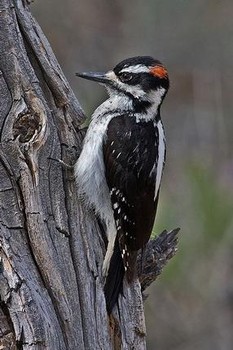Hairy Woodpecker
Category: Woodpeckers

Facts about Hairy Woodpeckers, "Scientific name for Hairy Woodpecker is Picoides villosus". Hairy Woodpecker is a Picoides variety of woodpecker that comes from the Picidae family. "Scientific name for Woodpecker Picidae". Hairy Woodpeckers are birds in the Class of "Aves".
The Hairy Woodpeckers are native to North America, and they are largely found in all types of forest environment all through Canada, the United States and central Mexico. The Hairy Woodpecker are one among the most extensively spread woodpeckers in North America, and the Hairy Woodpecker are one among the most challenging birds to categorize. The Hairy Woodpecker are birds of grownup forests across the continent. The Hairy Woodpecker come eagerly to backyards in forested regions, chiefly if the yard includes the grownup trees. Leaving the grownup trees and deceased trunks that are available for roosting and drumming will also assist to attract these and other varieties of woodpeckers. The Hairy Woodpecker are also largely found in suburbs, woodlots, cemeteries and parks, including forest edges, open forests of pine and oak, lately burned woods, and stand diseased by bark beetles.
Features
The Hairy Woodpecker is an average-sized woodpecker, with a body length, ranging from 7 13/64 inches to 10 13/64 inches (18.3 to 25.9 cm ), with the wingspan that ranges from 13 inches to 16 3/32 inches (33 to 40.9 cm). They have a body mass that ranges from 1.4 pounds to 3.4 pounds (.63 to 1.54 kg). There are more than 190 species of woodpeckers worldwide, but none of them are found in polar regions, Madagascar, New Zealand or Australia.
Hairy Woodpeckers have zygodactyl feet, having 4 fingers, which means they have two toes facing the front and two toes facing the back, that helps them to have a strong grip on trees vertically. The Hairy Woodpecker use these 8 fingers with their stiff central portion tail feathers to brace on trees as they climb.
The Hairy Woodpecker has a contrasting black and white color body, with black color wings that are checkered with white color. The head of the bird is fairly square and has two white color lines, and the male birds have a flash of red color toward the rear part of the head. A big white area runs down the middle part of the black color on the back of Hairy Woodpecker part of the body. Female Hairy Woodpeckers have the similar markings, but they lack the red head area, and their patch is black in color. The Hairy Woodpeckers have an elongated, straight bill, similar to a chisel, and rigid, elongated tail feathers to bend against the trunk of a tree. The bill is almost has the same length as that of the head.
The chest, throat and abdomen of the Hairy Woodpecker are white in color, but may demonstrate a brownish wash in the Pacific coast birds. A black-colored spur protrudes onto their shoulder, and the Hairy Woodpecker have a black-colored tail.
Male and female Hairy Woodpeckers are able to drum hollow trees logs execrate. Since Hairy Woodpeckers do not have vocal cords and don't sing, this pecking activity also plays an important role in communicating with each other. Hairy Woodpeckers drumming is also to attract a mate, mark out territory, both sexes are known to drum.
An average Hairy Woodpeckers tongue is up to 4 inches (10.16 cm) long. The length can be a little different depending on which species of woodpecker. Its tongue wraps around the reinforced skull structured and squashy bone, to even out the impact of the pecking force. Many Hairy Woodpeckers have barbed tongues that helps them remove bugs from holes and tree bark.
Feathers that look like hairs on the Hairy Woodpecker nostrils, prevent ingestion of wood particles.
The Hairy Woodpecker hitch up the trunk of a tree and along major branches. The Hairy Woodpecker occasionally feed at the bottoms of trees, along the fallen wood, and sometimes on the land. The Hairy Woodpecker have the gradually rolling flight model of most woodpeckers.
Diet
Hairy Woodpecker mostly feed on insects, seeds, nuts and sap.
When feeding, drumming and building a nest cavity, a Hairy Woodpecker can peck up to 20 times per second, wow that's fast! or a total between 9,000 and 12,000 pecks in a day.
Hairy Woodpeckers have a prominent surge in flight comprise of three rapid wing flaps, followed by a quick glide when the woodpeckers wings are tucked against its body rather than spread out like many other birds.
The average life span of a Hairy Woodpecker in the wild is 4 to 11 years, depending on the species and environment
Hairy Woodpeckers are omnivores; meaning - an animal that eats food of both animal and plant and origin.
Hairy Woodpeckers are monogamous meaning- the pair will mate for lifetime. Both male and female prepare the nest in the tree for babies and both will help feed them. The female Hairy Woodpecker will lay between 3 and 5 eggs and the incubation period will lasts 11 to 14 days. After one month of hatching, young woodpeckers will leave the nest and venture out on there own.
Hairy Woodpeckers possess a protective ocular mechanisms for protecting its eyes from shaking from the pecking impact. Hairy Woodpeckers show a restricted axial globe movement due to the tight fit within the fascial tissue connections and orbit between the sclera and orbital rim.
The eyes of the Hairy Woodpecker are covered with a nictitating membrane (from Latin nictare, to blink)— a translucent and transparent third eyelid - that protects the Hairy Woodpeckers eyes from flying debris while pecking.

 Back To Category Woodpeckers
Back To Category Woodpeckers